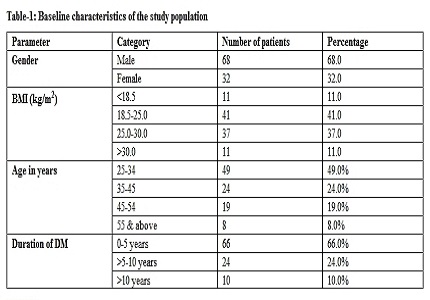Use of Latent autoimmune diabetes in adults clinical risk score in type 2 diabetes
Abstract
Background: Subjects with type 2 diabetes may harbour islet auto antibodies and this has implications on progression of disease and therapeutic options. Clinical tools to distinguish antibody positive individuals are essential to guide the therapy.
Objective: To develop a clinical risk score in subjects with Type 2 Diabetes to identify LADA.
Methods: We studied 100 persons aged between 25 to 65 years diagnosed as Type 2 Diabetes by FBS>126mg/dl and C-peptide >0.6 ng/ml.
Results: 17% of Type 2 Diabetic individuals were GAD positive. 11 were males and 6 were females. GAD positivity in the 25 to 34 years age group was 16.3%, 35 to 44 years age group was 20.8%, 45 to 54 years age group was 21.1%, and in >55 was 0% respectively. GAD positivity with respect to the duration of diabetes 0-5 years, 5-10 years and >10 years was 18.2, 12.3 and 20% respectively. 82.4% of GAD positive type 2 diabetes individuals had BMI <25 kg/m2 and age of onset of diabetes <50 years. Mean BMI, waist circumference and fasting C-peptide were 24.86±4.66, 87.55±10.78 and 2.49±1.41 in GAD negative Type 2 Diabetics. Mean BMI, waist circumference and fasting C-peptide were 21.65±3.46, 80.20±10.03 and 3.04±3.66 in GAD positive Type 2 Diabetics. All 17 GAD positive patients had LADA clinical risk score of 2 or more, So this score should be used in the clinic to suspect LADA patients.
Conclusions: LADA clinical risk score is ≥2 in all 17 GAD antibody positive subjects with Type 2 Diabetes. So this scoring system can be used as a tool to suspect LADA patients in the clinical setting. A multicentre study is necessary to further validate this scoring system.
Downloads
References
Matejkova-Behanova M. Latent autoimmune diabetes in adults (LADA) and autoimmune thyroiditis. Endocr Regul. 2001 Sep;35(3):167-72.
Rosário PW, Reis JS, Fagundes TA, Calsolari MR, Amim R, Silva SC, Purisch S. Latent autoimmune diabetes in adults (LADA): usefulness of anti-GAD antibody titers and benefit of early insulinization. Arq Bras Endocrinol Metabol. 2007 Feb;51(1):52-8.
Turner R, Stratton I, Horton V, Manley S, Zimmet P, Mackay IR, Shattock M, Bottazzo GF, Holman R. UKPDS 25: autoantibodies to islet-cell cytoplasm and glutamic acid decarboxylase for prediction of insulin requirement in type 2 diabetes. UK Prospective Diabetes Study Group. Lancet. 1997 Nov 1;350(9087):1288-93.
Zinman B, Kahn SE, Haffner SM, O'Neill MC, Heise MA, Freed MI; ADOPT Study Group. Phenotypic characteristics of GAD antibody-positive recently diagnosed patients with type 2 diabetes in North America and Europe. Diabetes. 2004 Dec;53(12):3193-200.
Lundgren V. Type 1 family history and GAD autoantibodies in subjects without diabetes and patients with type 2 diabetes: prevalence and association with insulin deficiency and development of diabetes.
Hagopian WA, Sanjeevi CB, Kockum I, Landin-Olsson M, Karlsen AE, Sundkvist G, Dahlquist G, Palmer J, Lernmark A. Glutamate decarboxylase-, insulin-, and islet cell-antibodies and HLA typing to detect diabetes in a general population-based study of Swedish children. Journal of Clinical Investigation. 1995 Apr;95(4):1505.
Jónsdóttir AM, Aspelund T, Sigurdsson G, Gudnason V, Benediktsson R. [Latent autoimmune diabetes in adults in Iceland: prevalence, phenotype and relatedness]. Laeknabladid. 2005 Dec;91(12):909-14.
Tuomi T, Carlsson A, Li H, Isomaa B, Miettinen A, Nilsson A, Nissén M, Ehrnström BO, Forsén B, Snickars B, Lahti K. Clinical and genetic characteristics of type 2 diabetes with and without GAD antibodies. Diabetes. 1999 Jan 1;48(1):150-7.
Al-Farwi AA, Khayat MI, MMuhsen AM. Latent autoimmune diabetes of adults in Latakia, Syria. International Journal of Endocrinology and Metabolism. 2010 Jan;2010(1, Winter):13-21.
Takino H, Yamasaki H, Abiru N, Sera Y, Abe T, Kawasaki E, Yamaguchi Y, Eguchi K, Kanazawa Y, Nagataki S. Antibodies to GAD in Japanese patients classified as Type 2 diabetes at diagnosis. High titre of GAD Ab is a predictive marker for early insulin treatment—report of west Japan (Kyushu, Yamaguchi, Osaka) study for GAD Ab (+) diabetes. Diabetic medicine. 2002 Sep 1;19(9):730-4.
Sanjeevi CB, Balaji M, Balaji V, Seshiah V. Autoantibodies to GAD65 and IA‐2 Antibodies Are Increased, but Not Tissue Transglutaminase (TTG‐Ab) in Type 2 Diabetes Mellitus (T2DM) Patients from South India. Annals of the New York Academy of Sciences. 2003 Nov 1;1005(1):387-9.
Sima A, Rosu M, Vlad A, Silberberg G, Serban V. Latent Autoimmune Diabetes in Adults (LADA). TMJ. 2003;53:241-5.
Romkens TE, Kusters GC, Netea MG, Netten PM. Prevalence and clinical characteristics of insulin-treated, anti-GAD-positive, type 2 diabetic subjects in an outpatient clinical department of a Dutch teaching hospital.
Fourlanos S, Perry C, Stein MS, Stankovich J, Harrison LC, Colman PG. A clinical screening tool identifies autoimmune diabetes in adults. Diabetes care. 2006 May 1;29(5):970-5.



 OAI - Open Archives Initiative
OAI - Open Archives Initiative


